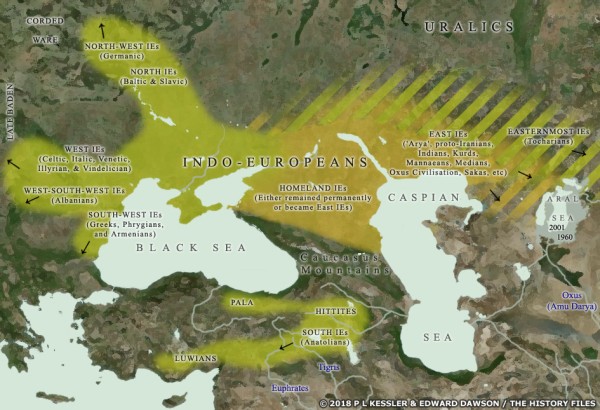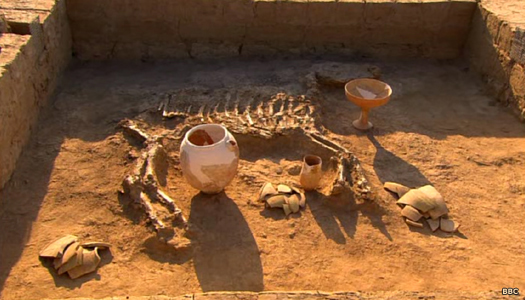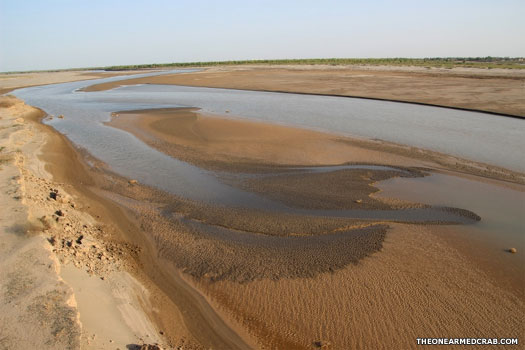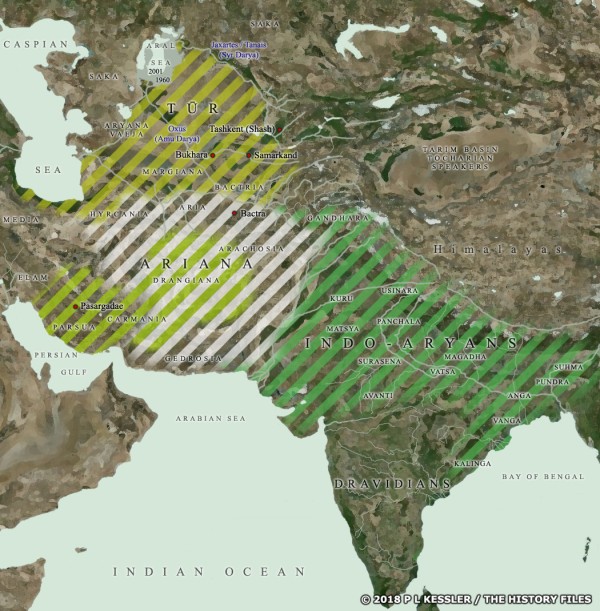
| INDO - IRANIANS / INDO - ARYANS Indo-Iranians and Indo-Aryans were the eastern descendants of Indo-Europeans. The terms 'Indo-Iranian' and 'Indo-Aryan' refer essentially to the same people, although with a division which was related to language dialect and geographical placement. The older term of 'Aryan' which was originally used to describe these peoples has rather distasteful connotations due to its use by the Nazis.
The groups which formed these two divisions appear to have originated to the north and east of the Caspian steppe. This was prior to the Yamnaya horizon event which saw the widespread outwards migration of Indo-Europeans (IEs). While the steppe dwellers generally headed west, the ancestors of the Indo-Iranians and Indo-Aryans moved east, displacing some earlier tribal populations of foragers with their horse-riding, cattle-herding sophistication. From there they spread out between southern Siberia and Central Asia, setting up two related cultures to the north of the Aral Sea and the Syr Daria (River Jaxartes/Tanais) which were eastward expressions of the Yamnaya.
The original spur for this sudden expansion lay in the Near East, somewhere between south-eastern Anatolia (today's Turkey) and northern Mesopotamia (modern Iraq), where cattle herding was invented when wild aurochs were tamed. This new economy quickly proved its worth and soon spread in all directions in which cattle could graze, along with the people who invented it. Some of them crossed the Caucasian Mountains (the western end on the Black Sea coast would be a favourite location for such a tricky crossing), and spread out amongst the steppe-dwelling proto-Indo-Europeans to the north of the mountains. This cattle herding technology was eventually augmented there by the use of the horse, vital for herding on the vast, open plains of the Pontic-Caspian steppe. The newcomers adopted the local language, and this appears to have formed the basis for centum-speaking Indo-Europeans (involving western Indo-European language groups).
In the forests to the north of this steppeland, relatively untouched groups of forager IEs slowly adapted to the new technology without being subsumed by the newcomers, probably via contact with their steppe-dwelling cousins; these were the satem variety of IE speakers (the later eastern language groups). They were the ancestors of Indo-Iranians, Indo-Aryans, Slavs, and Balts (Lithuanians, most Latvians, and Old Prussians), and they also provided part of the ancestry of Germanics (which explains why Germanics were notably different from their Celtic neighbours - see below). Once the horse was introduced, the great steppe nomad expansion soon occurred - known as the Yamnaya horizon - with IEs entering Central Europe, Anatolia, the Near East, and Central Asia. Eventually, India, the Iranian highlands, and eastern Asia would follow.
In Central Asia, two cultures which emerged were the Andronovo (actually an horizon) and Sintashta. These succeeded the Yamnaya horizon, seemingly as the aforementioned eastwards expressions of Yamnaya migration. It is these cultures that are most often cited as a possible birthplace of the proto-Indo-Iranian language. The earlier Abashevo and Poltavka cultures are also linked to this event - seemingly supplying the pastoral nomads who formed the later cultures. Farther south, the indigenous Bactria-Margiana Archaeological Complex (BMAC) soon emerged, centred in the later provinces of Bactria and Margiana. This provided a vital trading link between the proto-Indo-Iranians and the high cultures of Mesopotamia and Iran, and served to encourage the Andronovo and Sintashta people to develop their industries. It also seemed to encourage then to migrate southwards where they soon overran the BMAC during its later, weaker years. There they developed and then expanded into north-western South Asia, with further migrations into India (from about 1700 BC) and Iran (from about 1200-800 BC).
The Indo-European word 'arya' meant the 'civilised' or 'respectable' according to general scholarly opinion. This word, added to a plural suffix, possibly -na, produced Aryana, which is how these people referred to themselves. The East Indo-Europeans who supplied the tribes which formed the later Indo-Iranians and Indo-Aryans were documented as calling themselves Aryans when they entered India. This rather elitist naming is explained as a reaction to the apparently barbarous people they encountered, although an earlier reason may supply the true meaning because the name clearly predated the migration into India (its survival in Central Asia and Iran shows this). The 'barbarous people' were more likely those of the forager cultures encountered when the IEs first migrated to the east of the Caspian Sea, although at this stage the word may still have borne an earlier meaning - it could be seen as being the verb 'to be', used as a noun instead of a verb.
In reality Indo-Iranians and Indo-Aryans formed a single cultural and language group. The two terms are merely convenient ways of describing groups of them following a gradual division in Central Asia and then entering Iran (the Indo-Iranians) and India (Indo-Aryans). It does not specifically describe those who remained behind in the north of Central Asia (Scythians and Sarmatians), although since the Indo-Aryans of India were, to an extent, isolated on the other side of the Hindu Kush and River Indus, it is easier to relate the Central Asian stay-at-homes as Indo-Iranians, and this is usually what happens with modern scholars. In fact, the term 'Iranian' is only a later modified form of 'arya', as is 'Alan', with the Indo-Iranian Alani eventually settling in the northern Caucuses.
FeatureThe core of the early first millennium Indo-Iranian homeland in southern Central Asia and northern South Asia appears to have been the land of Tur (and the later kingdom of Turan). This was within an 'Asia' which may also be an Indo-Iranian name. The land of Tur appears to have focused mainly on the later provinces of Bactria and Margiana, along with the Kopet Dag region, the Atrek valley, and the eastern Alborz Mountains. This would appear to place it on the northern border of another ancient region, that of Ariana (another form of that same word - Aryana). The focus in Ariana is less clear, but this region was the gateway into India so that focus was probably eastwards. Bactra (modern Balkh) in Bactria is often considered to have been the first city reached by Indo-Iranian tribes moving southwards from the steppeland. They may have reached it between 2000-1500 BC, and it later became a centre of Zoroastrianism.
When it came to methods of worship, the East Indo-European rituals and gods were more male-centred than their West Indo-European counterparts (but certainly not exclusively - Rig Ved contains plenty of female goddesses). Eastern Yamnaya people shared borders with northern and eastern foragers who did not make female figurines, so they themselves may have seen less inclination to do so. In East Indo-European branches the spirit of the domestic hearth was male (Agni). In Indo-Iranian, the furies of war were male Maruts. Eastern Yamnaya graves on the Volga contained a higher percentage (80%) of males than any other Yamnaya region.
As for the Germanics and their notable differences from their Celtic neighbours, this is one peculiarity which has commonly been raised by linguists. There are a number of parallels between East IE Indo-Iranians and West IE Germanics. Frankly the presence of Germanic language-speaking peoples in Scandinavia makes no sense in terms of a smooth 'wave front' of Indo-European migration. They are an anomaly next to the Celts. They are more like the Aryana than they are the Celts. This includes exalting the Asuras as the Os and Æsir, and the use of that plural suffix, '-na', seen as '-an' and '-on' among some Germanic tribes, but still used as '-na' by the Angles, giving the English their spelling of Mercia as Mercna.
FeatureThe explanation seems either to be that the Germanics were formed by a northern group of IEs, one which probably lay at the border between centum (West) and satem (East) speakers and was influenced by both before they migrated to Scandinavia, or that a group of East IEs were either part of the migration of a West IE segment or followed on behind them to add that vital satem influence to their later language. A second wave of Indo-Iranian influences on Germanics seems to have taken place when the Goths dominated the northern Black Sea coast in the second century AD.
(Information by Peter Kessler and Edward Dawson, with additional information from the Encyclopaedia of Indo-European Culture, J P Mallory & D Q Adams (Eds, 1997), from The Persian Empire, J M Cook (1983), from The Horse, the Wheel, and Language: How Bronze-Age Riders from the Eurasian Steppes Shaped the Modern World, David W Anthony, from A Genetic Signal of Central European Celtic Ancestry, David K Faux, from the BBC Radio 3 programme with Bettany Hughes, Tracking the Aryans, 2011, from The Turks in World History, Carter Vaughn Findley (Oxford University Press 2005), from Ethnogenesis in the tribal zone: The Shaping of the Turks, Peter Benjamin Golden (2005), and from External Links: Massive migration from the steppe was a source for Indo-European languages in Europe, Nature.com, and Peering at the Tocharians through Language, and Indo-European Chronology - Countries and Peoples, and also Indo-European Etymological Dictionary, J Pokorny, and Zarathustra (Encyclopaedia Britannica).)
c.3000 BC :
A date of around 3000 BC is generally used as the probable point at which Indo-Europeans begin to separate into definite proto languages which are not intelligible to each other. A western group will evolve into or subsume Celtic, Italic, Venetic, Illyrian, Ligurian, Vindelician/Liburnian and Raetic branches.
An eastern branch - or perhaps a branch that stays in the steppe homeland for another millennium or so and which therefore becomes an eastern branch by default because the rest have headed off west - apparently calling themselves Arya or something similar form the ancestors of much of India's modern population (except for the southernmost parts - see 2200 BC, below), plus Kurds, Persians, Mannaeans, Medians, Mitanni, and related peoples, possibly also including the Sakas.
By around 3000 BC the Indo-Europeans had begun their mass migration away from the Pontic-Caspian steppe, with the bulk of them heading westwards towards the heartland of Europe c.2300 BC :
The Andronovo horizon succeeds the Yamnaya horizon which itself had seen the massive outward migration of Indo-European tribes, mostly westwards. The Andronovo appears to be an eastwards expression of Yamnaya migration. While it is usual to link this culture to the Indo-Iranian migrations as a possible birthplace of proto-Indo-Iranian, that process may already have been triggered during the preceding Poltavka culture, this being an expression of the Yamnaya. Indo-Aryan dialects begin to emerge further to the south, with possible influence from a major indigenous culture there.
c.2200 - 2000 BC :
An indigenous Bronze Age culture emerges in Central Asia between modern Turkmenistan and down towards the Oxus, the somewhat nebulous region known as Transoxiana. It is known as the Bactria-Margiana Archaeological Complex, or Oxus Civilisation (centred on the later provinces of Bactria and Margiana). Indo-European tribes which have not taken part in the exodus to the west or south soon integrate themselves into it, firstly through trade but later with encroaching settlement and social integration which serves to influence early southern proto-Indo-Iranians into becoming an Indo-Aryan division.
It may also be this Oxus culture, or a neighbouring Indo-European group which feeds off its progressive nature, which forms the 'spiral cities' of the Kazakhstan steppe. Items that have so far been recovered from recent exploration in this region include make-up equipment, a chariot, and numerous pieces of pottery. The artefacts are daubed in swastikas (symbols of the sun and of eternal life). Evidence of ritual horse burials are also found, which ties in with ancient Indo-Aryan texts that describe the animals being sliced up and buried with their masters.
Given the fact that they appear in Anatolia around the same time, the Andronovo people and other Indo-Europeans who integrate into the Oxus may be related to the Anatolian branch of Indo-European languages which had begun to divide from the other branches around 3500 BC. Alternatively, they may be related to the comparatively late migration of the Indo-Iranians who become the Alani, Mannaeans, Medians, Mitanni, Persians, Scythians, and Indians, and possibly also the Sakas. The latter seems most likely. The Mitanni may be a slightly earlier-migrating group of Indo-Aryans.
This king's tomb in the Indo-European settlement in the Karakum (modern Turkmenistan) contains a valuable horse to accompany him into the afterlife 2100 - 1700 BC :
The Sintashta culture is also linked to Indo-Iranian migrations. This succeeds the Yamnaya horizon and the Abashevo culture, appearing to be an eastwards expression of Yamnaya migrations.
Climate change from around 2000 BC onwards greatly affects the BMAC, denuding it of water as the rains decline. The people are forced to migrate away, abandoning many of their cities. Indo-Iranian groups become dominant here, and over time some of their descendants enter Iran to found states such as that of the Mannaeans, the Median empire, and early Persia. Some go even farther even earlier to form the Mitanni empire. Others cross the rivers of modern Afghanistan and the Hindu Kush mountains and enter India between 1700-1500 BC. They eventually form their own kingdoms there such as Magadha, plus Kalinga, and the Kaurava state.
c.1900 - 600 BC :
The Cemetery H Bronze Age culture is linked to the late Harappan Indus Valley culture and the Indo-Aryan migrations. It is one of a series of cultures that can be linked to the Indo-Aryans (Cemetery H, Swat, Copper Hoard, and Painted Greyware), each of which progresses in succession farther south-eastwards along the Ganges plain, showing a migration pattern that does indeed seem to link up with what is known about the Indo-Aryan arrival in India.
However, Cemetery H can also be claimed as a late expression of Harappan Indus Valley culture. Possibly its a combination of both, with refugees from the Indus collapse joining the Indo-Aryan migration. The Black & Redware culture (BRW, of about 1200-900 BC) is often also linked to the Indo-Iranian migrations and to late Harappan pottery, although in this case it is more likely a late expression of the overall Indus Valley culture.
c.1339 BC :
Devastatingly defeated by the Hittites in a shock reversal of fortunes, by now, the Indo-Iranian Mitanni warrior class has been totally absorbed into the Hurrian populace, leaving little trace of its existence, including its language.
c.1000 BC :
The Parsua begin to enter Iran, probably by crossing the Iranian plateau to the north of the great central deserts (through Hyrcania) but also by working round to the south of them. Already separated during their journey, Parsua groups head in two main directions. In time the northern groups find themselves in the Zagros Mountains alongside their cousins, the Mannaeans and Medians. They are attested there during the ninth and eighth centuries but disappear afterwards. The southern groups, perhaps more numerous, trickle in through Drangiana and Carmania, towards southern Iran and begin to settle there.
The River Oxus - also known over the course of many centuries as the Amu Darya - was used as a demarcation border throughout history - it was also a hub of activity in prehistoric times, providing a home to the Bactria-Margiana Archaeological Complex, or Oxus Civilisation Located in the Fars region of Iran, these Parsua come under the overlordship of their once-powerful western neighbour, the kingdom of Elam. In the later stages of Parsua settlement, Assyria and Media also claim some control over the region. As Elam's influence weakens, the Parsua begin to assert their own authority in the region, although they remain subjugated by more powerful neighbours for quite some time.
c.843 BC :
The Parsua receive their first mention in history. The Assyrian king, Shalmaneser III, records their existence on the Black Obelisk, which covers his campaign of about this year. Their position is not precisely fixed but 'Pasua' seems to lay in what is now Iranian Kurdistan (immediately east of Kurdistan in northern Iraq), far to the north of Persis and the heart of Parsuan/Persian settlement. They also occupy territory which stretches back into the east, seemingly along the Great Khorasan Road which follows the southern edge of the Elburz Mountains on the south coast of the Caspian Sea (largely within the later province of Hyrcania).
It may be the case that there are two (or perhaps even three) distinctive groups of 'Parsua' at this time, primarily in the Zagros Mountains to the east and south-east of the Assyrians. This is apart from a larger body which is settling the land immediately to the east of Elam (and focussed around the city of Persis). Those groups in the Zagros seem to drop out of the historical record towards the end of the eighth century BC (after 714 BC), perhaps pushed south by the greater numbers of the Medes or absorbed by them.
836/835 BC :
The Medes are mentioned for the first time in historical records when Shalmaneser III of Assyria receives tribute from the 'Amadai' after fighting wars against the tribes of the Zagros Mountains. Living in the central Zagros along the Khorasan road, the Medes are usually mentioned in conjunction with the Scythians, another steppe group which appears to be the dominant force in the region.
The Zagros Mountain range provided the Medes with their home, but it was also the Assyrian gateway into Iran, one that was used in later attacks on the Indo-European Persians and Medes 9th century BC? :
Later myth ascribes a dynasty of Persian rulers to this period, as described in the Shahnameh (The Book of Kings), a poetic opus which is written about AD 1000 but which accesses older works and perhaps elements of an oral tradition. The Kayanian dynasty of kings are also the heroes of the Avesta, which forms the sacred texts of Zoroastrianism. This faith itself had been founded along the banks of the River Oxus, which had probably also formed part of the migratory route used by the Indo-Iranian Persians as they entered Iran.
The earliest of these rulers is Fereydun, king of a 'word empire' which is apparently centred on the land of Tur. This can be equated to territory in the heartland of Indo-Iranian southern Central Asia and South Asia, focused mainly on the later provinces of Bactria and Margiana, along with the Kopet Dag region, the Atrek valley, and the eastern Alborz Mountains. Fereydun becomes the father of Tur, Salm, and Iraj. A descendant of the first of these (possibly a seven-times grandson) is Afrasaib, who still rules the kingdom of Turan during the lifetime of the Persian Kai Kavoos of the seventh century.
c.700 - 200 BC :
The Northern Black Polished Ware culture succeeds the Painted Greyware, This is another culture which is often linked to Indo-Aryan migration which has seen Indo-Aryan control of areas of northern and central India for up to eight hundred years. Additionally, various later groups or tribes in India can be ascribed an Indo-Aryan origin, including the Jats, who may be descendants of the Sakas in the latter's guise as the Indo-Scythians.
7th century BC :
Sijavus is a legendary Persian prince and the son-in-law of the mythical Afrasiab, the hero and king of Turan. Turan is the ancient Iranian name for Central Asia, 'land of the Tur', which is inhabited by Iranian peoples. Due to the treachery of his stepmother, Sudabeh, Sijavus exiles himself to Turan. There, he marries Farangis, the daughter of Afrasiab, but the king later orders Sijavus to be killed. His death is avenged by his son, who inherits the early Persian throne.
Following the climate-change-induced collapse of indigenous civilisations and cultures in Iran and Central Asia between about 2200-1700 BC, Indo-Iranian groups gradually migrated southwards to form two regions - Tur (yellow) and Ariana (white), with westward migrants forming the early Parsua kingdom (lime green), and Indo-Aryans entering India (green) c.628 - c.551 BC :
Zarathustra (also shown as Zarathushtra, the Greek Zoroaster) is traditionally thought to be born around 628 BC, possibly in Rhages in Iran. As the founder of Zoroastrianism he proves to be a major figure in the history of world religion, apparently encouraging monotheism (in his concept of one god, whom he refers to as Ahura Mazda, or the 'Wise Lord', with 'ahura' equalling 'Asura' in Vedic/Hindu theology), his purported dualism (evident in the stark distinction he draws between the forces of good and evil), and the possible influence of his teachings on subsequently-emerging Middle Eastern religions (such as Judaism). He is supported in his efforts by King Vishtasp of the land of Aryana Vaejah.
c.546 - 540 BC :
By this stage various Indo-Iranian and Indo-Aryan groups have entered history as kingdom-founders. In this period the defeat of the Medes opens the floodgates for Cyrus the Great with a wave of conquests, beginning in the west from 549 BC but focussing towards the east of the Persians from about 546 BC. Eastern Iran falls during a drawn-out campaign between then and about 540 BC, during which the further eastern regions of Arachosia, Aria, Bactria, Carmania, Chorasmia, Drangiana, Gandhara, Gedrosia, Hyrcania, Margiana, Parthia, Saka (at least part of the broad tribal lands of the Indo-Iranian/Aryan Sakas), Sogdiana (with Ferghana), and Thatagush - all added to the empire, although records for these campaigns are characteristically sparse.
Many, if not most of the peoples of these conquered regions appear to exhibit an Indo-Iranian or Indo-Aryan heritage. Various Persian royal inscriptions list the provinces or depict local representatives, with those of Haraiva wearing Scythian-style dress which includes a tunic over trousers which are tucked into high boots. The twisted turban in the head provides the final touch, and perhaps all the proof that is needed that these are an Indo-Iranian people with close links to the Indo-Europeans of the Pontic-Caspian steppe.
AD 500 :
Around the Altai Mountains, to which the earliest migration of Tocharians had headed, the Türük people (Göktürks) are vassals of the Rouran khaganate. One theory about their origins suggests that they are Turkified Indo-Europeans, making them Tocharians or Indo-Iranians who have intermarried with proto-Turkic groups. Other local groups such as the Wusun exhibit similar connections, albeit at an earlier stage of the process of development.
The Altai Mountains link together the borders of Kazakhstan, Mongolia, Russia, and Xinjiang, providing the source for the rivers Irtysh and Ob and also, it would seem, the source region for the early Turkic tribes It is believed that the Türük name is for an eponymous dynastic ancestor, of the Ashina tribe (which can also be shown as Asen, Asena, Ashinas (in Islamic texts), or Açina). In The Turks in World History, Carter Vaughn Findley points out that the Ashina name probably originates from one of the Indo-Iranian languages of Central Asia. Findley's observation is seconded by Peter Benjamin Golden and also by the Hungarian researcher, András Róna-Tas, who finds it highly plausible 'that we are dealing with a royal family and clan [that is] of Iranian origin, almost certainly Saka'.
If that origin provides anything more than simple cultural influences then this would mean that the Ashina core tribe of early Turks is almost certainly of Indo-European origin. Many other early Turkic groups (if not most and later ones too, including the Azeris) also exhibit traces of shared Mongoloid and Indo-Iranian heritage. The Indo-Europeans and their various branches had been the first horse-borne nomads. The Turks, Huns, Magyars, Mongols, Xionites, and later nomads who followed the same way of life have all, ultimately, learned from the Indo-Europeans - specifically in most cases the Indo-Iranians - and have held them in high esteem whilst doing so.
Source :
https://www.historyfiles.co.uk/ |





